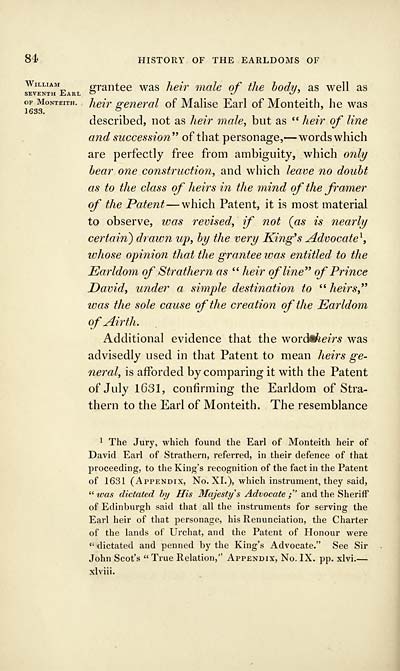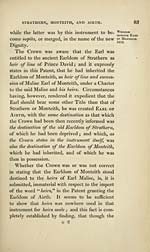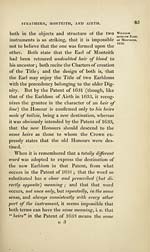Download files
Complete book:
Individual page:
Thumbnail gallery: Grid view | List view

84 HISTORY OF THE EARLDOMS OF
William CTantec was lieiv male of the body, as well as
SEVENTH Earl o ./ kJ '
OF MoNTBiTH. Jigi^ ffenej'al of Malise Earl of Monteith, he was
1633. ^
described, not as heir male, but as " heir of line
and succession** of that personage, — words which
are perfectly free from ambiguity, which onli/
bear one construction, and which leaiw no doubt
as to the class of heirs in the mind of the framer
of the Patent — which Patent, it is most material
to observe, was revised, if not (as is nearly
certain) drawn up, by the very King's u4dvocate^,
whose opinion that the grantee was entitled to the
Earldom of Strathern as " heir of line'' of Prince
David, under a simple destination to " heirs,"
was the sole cause of the creation of the Earldom
ofAirth.
Additional evidence that the wordnfeezV* was
advisedly used in that Patent to mean heirs ge-
ne7'al, is afforded by comparing it with the Patent
of July 1631, confirming the Earldom of Stra-
thern to the Earl of Monteith. The resemblance
1 The Jury, which found the Earl of Monteith heir of
David Earl of Strathern, referred, in their defence of that
proceeding, to the King's recognition of the fact in the Patent
of 1631 (Appendix, No. XL), which instrument, they said,
"was dictated hy His Majesty's Advocate ;" and the Sheriff
of Edinburgh said that all the instruments for serving the
Earl heir of that personage, his Renunciation, the Charter
of the lands of Urchat, and the Patent of Honour were
" dictated and penned by the King's Advocate." See Sir
John Scot's " True Relation," Appendix, No. IX. pp. xlvi. —
xlviii.
William CTantec was lieiv male of the body, as well as
SEVENTH Earl o ./ kJ '
OF MoNTBiTH. Jigi^ ffenej'al of Malise Earl of Monteith, he was
1633. ^
described, not as heir male, but as " heir of line
and succession** of that personage, — words which
are perfectly free from ambiguity, which onli/
bear one construction, and which leaiw no doubt
as to the class of heirs in the mind of the framer
of the Patent — which Patent, it is most material
to observe, was revised, if not (as is nearly
certain) drawn up, by the very King's u4dvocate^,
whose opinion that the grantee was entitled to the
Earldom of Strathern as " heir of line'' of Prince
David, under a simple destination to " heirs,"
was the sole cause of the creation of the Earldom
ofAirth.
Additional evidence that the wordnfeezV* was
advisedly used in that Patent to mean heirs ge-
ne7'al, is afforded by comparing it with the Patent
of July 1631, confirming the Earldom of Stra-
thern to the Earl of Monteith. The resemblance
1 The Jury, which found the Earl of Monteith heir of
David Earl of Strathern, referred, in their defence of that
proceeding, to the King's recognition of the fact in the Patent
of 1631 (Appendix, No. XL), which instrument, they said,
"was dictated hy His Majesty's Advocate ;" and the Sheriff
of Edinburgh said that all the instruments for serving the
Earl heir of that personage, his Renunciation, the Charter
of the lands of Urchat, and the Patent of Honour were
" dictated and penned by the King's Advocate." See Sir
John Scot's " True Relation," Appendix, No. IX. pp. xlvi. —
xlviii.
Set display mode to:
![]() Universal Viewer |
Universal Viewer | ![]() Mirador |
Large image | Transcription
Mirador |
Large image | Transcription
Images and transcriptions on this page, including medium image downloads, may be used under the Creative Commons Attribution 4.0 International Licence unless otherwise stated. ![]()
| Histories of Scottish families > History of the earldoms of Strathern, Monteith, and Airth > (112) Page 84 |
|---|
| Permanent URL | https://digital.nls.uk/94881186 |
|---|
| Description | A selection of almost 400 printed items relating to the history of Scottish families, mostly dating from the 19th and early 20th centuries. Includes memoirs, genealogies and clan histories, with a few produced by emigrant families. The earliest family history goes back to AD 916. |
|---|

